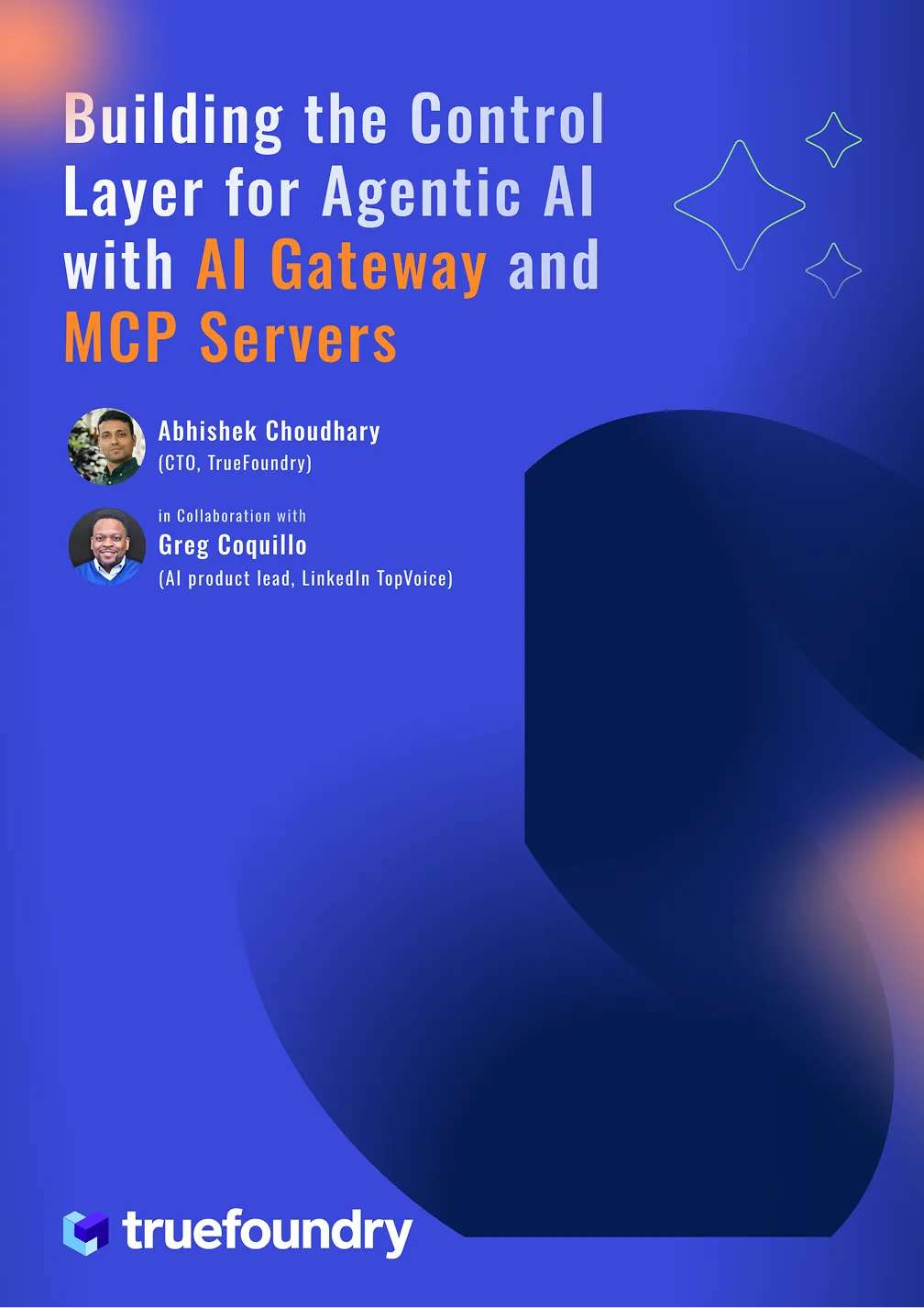Vendor Lock-In Prevention with TrueFoundry’s AI Gateway
Introduction
As enterprises scale their AI initiatives, one of the biggest architectural risks they face is vendor lock-in—being tied too tightly to a single model provider or cloud platform. In the rapidly evolving AI ecosystem, where new foundation models and APIs emerge almost weekly, this dependency can quickly limit innovation and flexibility. Teams that commit early to one ecosystem often find themselves unable to adopt newer, better, or more cost-effective models without rewriting large portions of their stack. Preventing lock-in, therefore, is not just a procurement concern—it’s a core technical design challenge.
The risk of vendor lock-in is a critical concern when designing enterprise AI systems. If your AI applications are tightly coupled to a single provider’s APIs, you may find it difficult to adapt when technology, pricing, or compliance needs change. An AI model gateway solves this by acting as an abstraction layer between your applications and multiple model providers. In practice, this means your code talks to the gateway’s unified interface rather than to each vendor directly. The gateway then routes and translates requests to the optimal underlying model (OpenAI, Anthropic, Gemini, a self-hosted LLaMA, etc.) without your application code needing any vendor-specific changes. TrueFoundry’s AI Gateway exemplifies this approach – it offers a single, OpenAI-compatible API to access 1000+ LLMs and vision models, while enforcing enterprise security, governance, and observability. By design, TrueFoundry prevents lock-in: you keep full control over deployment and data formats, and your application code remains vendor-agnostic.
Understanding Vendor Lock-In in AI Systems
Vendor lock-in occurs when your system becomes so tied to one provider that switching to another is impractical or costly. In AI/ML, this often means writing code directly against one vendor’s SDK or API. While using a single provider (e.g. OpenAI) can be simple at first, it creates dangerous dependencies. For instance, if your integration uses OpenAI’s proprietary API calls, you’ll struggle to migrate if OpenAI’s service is unavailable, changes terms, or a new model (such as Google’s Gemini or a cutting-edge open-source model) becomes superior.
The TrueFoundry team highlights this “Vendor Lock-in Trap”: a hard-coded integration forces you to scramble whenever providers change pricing, deprecate models, or go down for maintenance. More broadly, lock-in shows up as high switching costs – technical (rewriting code for new APIs), contractual (breaking long-term commitments), process (retraining teams), or data formats (moving proprietary data).
Evaluating software for lock-in risk means asking: Can we easily change providers if needed? and Are we forced into proprietary SDKs or data formats? As Progress Software notes, lock-in is less about initial convenience and more about long-term flexibility. You should think of lock-in like any technical debt: plan your architecture to keep options open. In practice, this means favoring open standards (e.g. OpenAI API, Parquet data), containerized deployments, and abstraction layers (like gateways) that allow underlying components to swap out. TrueFoundry’s AI Gateway ensure the application code never contains provider-specific calls, so you won’t be locked to a single AI vendor.
What Is an AI Model Gateway?
An AI model gateway (also called an LLM or AI gateway) is a middleware layer that sits between your application and any number of AI model providers. It functions like an air-traffic controller or translator: your app issues a single API request to the gateway, and the gateway decides which model instance or vendor to use. The gateway then standardizes the input/output formats and handles security and routing behind the scenes. This unified interface means you never write model-specific code in your application.

Figure: TrueFoundry AI Gateway architecture (proxy layer between applications and multiple LLM providers).
For example, TrueFoundry’s gateway accepts requests in an OpenAI-compatible format; it can then route the query to OpenAI, Anthropic, a self-hosted model, or any other integrated provider without changing your code.
In essence, an AI gateway provides model abstraction, policy enforcement, and multi-model orchestration in one place. It also adds enterprise capabilities (like RBAC, rate limits, cost controls, and audit logging) on top of each request, treating AI models as managed services. By decoupling the application from provider-specific APIs, gateways dramatically reduce the engineering burden when working with multiple LLMs.
How AI Model Gateways Help Prevent Vendor Lock-In
AI gateways prevent lock-in by abstracting away provider details. Because your application talks only to the gateway’s unified API, you never hard-code vendor-specific endpoints. For example, TrueFoundry’s gateway supports any OpenAI-compatible model, so if you write your code against TrueFoundry’s OpenAI-style API, you can switch between OpenAI, Azure OpenAI, Anthropic, or your own models with a configuration change – no code rewrite required. This decoupling is critical.
TrueFoundry deliberately uses the standard OpenAI API format for all requests, meaning you can continue using the familiar OpenAI SDK or client libraries. You simply send requests to TrueFoundry’s gateway instead of directly to a vendor. Under the hood, the gateway translates those calls into the appropriate vendor API calls as needed.
TrueFoundry also avoids introducing its own custom SDK. Instead, developers use existing tools and SDKs as before – whether it’s OpenAI’s or another open-source client – and point them at the gateway endpoint. In effect, there is no new “lock-in” created by using TrueFoundry, because you never have to “buy in” to a proprietary interface. Moreover, TrueFoundry’s data formats and logs are all open-standard: for instance, logs are stored in Apache Parquet on customer-managed S3, and metrics use OpenTelemetry. This means you can export and analyze data with any tool you like, further preventing any data-vendor entanglement. In short, by acting as a translator and control plane, AI gateways like TrueFoundry’s ensure you can swap model providers, move workloads to another environment, or even self-host models without rewriting application code.
Architectural Overview: How It Works
TrueFoundry’s AI Gateway is engineered for high availability and minimal latency while enforcing policy at scale. Its core is a split control-plane/data-plane architecture. In essence, the control-plane (a central service) manages configuration, models, users, and policies, while lightweight gateway pods process inference requests. These gateway pods are written in a high-performance, event-driven framework (Hono) and are CPU-bound for efficiency.
When a request arrives, the gateway performs all checks in-memory: it validates your JWT token and permissions, applies rate limits or budget caps, and determines which model to use. Importantly, the request enters in the standard OpenAI-compatible JSON format. The gateway then uses its configured routing rules to pick a model provider (e.g. the fastest or cheapest). A built-in adapter component translates the request into the specific format expected by that provider’s API. For example, if the chosen model is on AWS Bedrock or Anthropic, the gateway converts the OpenAI-style request appropriately. This means your app’s code never changes, even though different providers may expect different parameters.
Once the model responds, the gateway returns the output to your app. Simultaneously, it asynchronously logs the request and response (tokens, latency, cost, etc.) into a central store. These logs flow into the analytics backend in your own cloud (TrueFoundry writes them as Parquet into S3 or an S3-compatible store). In brief, TrueFoundry’s design ensures no external calls are needed in the request path (aside from caching), all policy decisions are in-memory, and request logs are decoupled and durable. The result is an AI gateway that adds only ~3–5ms of overhead per call, even at hundreds of requests per second. Its clustered deployment on Kubernetes (via Helm charts) gives you the freedom to run it anywhere – public cloud, private data center, or edge – without changing the application layer.

Figure: High-availability architecture of TrueFoundry’s AI Gateway (control-plane & gateway pods).
Internally, TrueFoundry uses a central database (e.g. PostgreSQL) and NATS message queue for configuration distribution. All gateway pods subscribe to real-time updates (users, models, quotas, metrics) via NATS, so policy changes propagate instantly. If a primary provider is unavailable, the gateway can automatically retry or failover to a fallback model. This modular, Kubernetes-native design – combined with an API-driven approach – guarantees you’re never locked into TrueFoundry’s infrastructure. You get the manifests and helm charts, and you retain full control over deployment details.
Benefits of Using AI Model Gateways
1. Vendor Agnosticism & Flexibility: By design, an AI gateway makes your AI stack provider-agnostic. TrueFoundry’s unified API lets you seamlessly connect to any OpenAI-compliant endpoint or 1000+ supported LLMs and vision models. You can switch underlying models (e.g. GPT, Claude, LLaMA, Mistral, Gemini, etc.) without touching your application code – a direct defense against lock-in.
2. Unified Interface & Multi-Model Support: One gateway endpoint replaces numerous vendor APIs. This simplifies development (one integration to maintain) and enables intelligent multi-model orchestration. You gain features like smart routing (send requests to the fastest or cheapest model) and fallback handling automatically.
3. Enterprise Controls: Gateways natively handle enterprise needs. TrueFoundry’s gateway enforces authentication (API keys, OAuth, etc.), fine-grained RBAC, rate-limiting, and content guardrails on every call. It also captures audit logs for compliance. These safeguards apply uniformly across all models and providers, unlike custom integrations.
4. Cost and Usage Management: Since AI gateways see every request, they can track token usage and budgets. TrueFoundry provides real-time cost tracking and budget caps per team or model, helping avoid runaway charges. This centralized cost control is far easier than poking holes into each vendor’s console.
5. Observability & Open Standards: Gateway-centric logging and telemetry give unparalleled visibility into AI workloads. TrueFoundry’s logs are OTel-compliant and in open formats, so you can route them to any observability tool (e.g. Datadog, Grafana). Because data lives in your own S3 buckets as Parquet, you truly own your analytics; this avoids any hidden data lock-in.
6. Scalability & Reliability: A well-built gateway adds minimal overhead. TrueFoundry’s benchmarks show only ~3–4ms extra latency at ~250 RPS on a single CPU core. The gateway scales horizontally, and its design (no single point of failure in request path) ensures high availability. In short, you get enterprise-grade reliability without sacrificing performance.
7. Ecosystem Integration: TrueFoundry exposes a 100% API-driven platform. You can integrate it into CI/CD (GitOps), use their Terraform provider or Helm charts, and hook into external tools. For example, guardrail outcomes or metrics from TrueFoundry can feed into SIEM or governance tools via OpenTelemetry. Such openness means you retain choice in your tooling.
Best Practices for Vendor Lock-In Prevention
To guard against lock-in, apply these principles:
- Decouple Application Logic: Always interact with models through an abstraction (like an AI gateway) rather than calling vendor APIs directly. This keeps vendor-specific code out of your business logic.
- Use Open Standards: Favor providers and platforms that use open protocols/formats. TrueFoundry’s use of the OpenAI API spec and standard data formats (Parquet, OTel) is an example. This way you can pivot to new tools or vendors without proprietary hurdles.
- Containerize and Self-Host: Deploy your AI stack on common infrastructures (e.g. Kubernetes) so you can move it between clouds or on-prem. TrueFoundry provides Kubernetes manifests, so you have full deployment control.
- Maintain Data Portability: Store models and logs in neutral formats under your control. TrueFoundry ensures logs go to customer-managed storage and even supports hosting your own model servers (MCP servers) behind the gateway.
- Plan Migration Paths: Regularly test moving components. TrueFoundry’s philosophy explicitly makes migration easy: your code stays the same and the deployment specs are open.
- Evaluate Licensing and Pricing: Avoid vendor models that penalize exits. TrueFoundry’s seat-based pricing (rather than per-usage fees) is designed so you aren’t surprised by cost changes when scaling.
- Document and Limit Vendor-Specific Extensions: If you must use any vendor-only features, isolate them so the core system remains general. Ideally, reduce these over time.
By building these habits – abstraction, standardization, and control – you dramatically lower the risk of lock-in.
Comparison: Gateway vs Direct API Integration
As the table shows, direct integration may be simplest for a small, single-model proof-of-concept, but it quickly becomes brittle in production. TrueFoundry’s AI Gateway introduces a tiny, predictable performance cost (just a few milliseconds) in exchange for massive gains in flexibility and control. In most enterprise scenarios, that trade-off is well worth it to avoid vendor lock-in and to gain enterprise-grade features out of the box.
Evaluating AI Model Gateways for Vendor Lock-In Prevention
When choosing an AI gateway (or any AI platform), consider these lock-in factors:
- Multi-Vendor Support: Does the solution support all major LLM providers and allow self-hosted models? TrueFoundry’s gateway integrates with hundreds of models and lets you add OpenAI-compatible models easily. A narrow gateway means more lock-in.
- Open APIs and SDKs: Is there a proprietary SDK, or can you use industry-standard libraries? TrueFoundry’s compatibility with the OpenAI API lets you use existing SDKs as-is. Avoid tools that force a closed SDK.
- Data Portability: Can you export your logs, model data, and metrics in open formats? TrueFoundry writes logs as Parquet in your S3 and uses OpenTelemetry for metrics. Gateways that keep data trapped in proprietary databases increase lock-in risk.
- Deployment Freedom: Are you tied to one cloud region or can you run on-premises? TrueFoundry offers both SaaS and self-hosted options on any Kubernetes environment. A gateway that only runs in the vendor’s cloud creates long-term dependency.
- Pricing Model: Does the cost structure penalize growth or switching? TrueFoundry’s seat-based pricing is designed to keep you productive without surprising scale fees. Examine how a vendor’s pricing changes if you scale up or migrate.
- Ecosystem Integration: Can the gateway work with your existing toolchain (CI/CD, monitoring, security)? TrueFoundry has APIs, GitOps support, and connectors for popular ML frameworks (LangChain, etc.). If a gateway forces you to adopt an entirely new workflow, that’s a red flag.
In short, look for open, modular designs (like TrueFoundry’s split-plane and plugin-based modules), portable data, and full visibility into how the system operates. TrueFoundry’s approach – modular, Kubernetes-native, and using open standards – checks these boxes to minimize lock-in. Their philosophy is clear: “zero vendor lock-in” so you can migrate or evolve your AI stack on your own terms.
Conclusion
Vendor lock-in is a hidden cost of AI development that can leave organizations vulnerable to price hikes, outages, and stagnation. Using an AI model gateway is one of the most effective ways to avoid these pitfalls. By funneling all model requests through a unified, agnostic interface, gateways eliminate hard-coded dependencies on any single provider. TrueFoundry’s AI Gateway embodies this approach: it decouples your application from specific LLM APIs, embraces open standards, and ensures you retain full control over infrastructure and data. The result is greater agility – you can evaluate new models, shift workloads between clouds, or deploy on-premise without rewriting core code.
In short, think of an AI gateway as an insurance policy against lock-in. TrueFoundry’s implementation goes even further by offering enterprise-grade features (RBAC, observability, cost controls) and open portability, so your AI systems remain flexible, scalable, and future-proof.
Built for Speed: ~10ms Latency, Even Under Load
Blazingly fast way to build, track and deploy your models!
- Handles 350+ RPS on just 1 vCPU — no tuning needed
- Production-ready with full enterprise support
TrueFoundry AI Gateway delivers ~3–4 ms latency, handles 350+ RPS on 1 vCPU, scales horizontally with ease, and is production-ready, while LiteLLM suffers from high latency, struggles beyond moderate RPS, lacks built-in scaling, and is best for light or prototype workloads.








.png)










